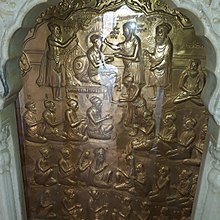ਮੰਜੀ (ਸਿੱਖ ਧਰਮ)
ਮੰਜੀ ਇੱਕ ਸਿੱਖ ਧਾਰਮਿਕ ਪ੍ਰਬੰਧਕੀ ਇਕਾਈ ਸੀ ਅਤੇ ਇਹ ਪ੍ਰਬੰਧਕੀ ਵੰਡ ਮਰਦਾਂ ਵਿੱਚ ਸਿੱਖ ਧਰਮ ਦੇ ਪ੍ਰਚਾਰ ਲਈ ਸੀ। [1] ਇਹ ਸਿੱਖ ਧਰਮ ਦੇ ਤੀਜੇ ਗੁਰੂ, ਗੁਰੂ ਅਮਰਦਾਸ ਨੇ ਆਪਣੇ ਧਰਮ-ਸਾਧਕਾਂ ਨੂੰ ਵੱਖ ਵੱਖ ਇਲਾਕਿਆਂ ਵਿੱਚ ਧਰਮ-ਪ੍ਰਚਾਰ ਦੀ ਜ਼ਿੰਮੇਵਾਰੀ ਸੌਂਪੀ ਅਤੇ ਸਿੱਖਾਂ ਵਿਚ ਮੰਜੀ ਉਤੇ ਬੈਠ ਕੇ ਪ੍ਰਵਚਨ ਕਰਨ ਦੀ ਪ੍ਰਥਾ ਚਲਾਈ। ਇਸ ਪ੍ਰਕਾਰ ਦੇ ਕੇਂਦਰਾਂ ਦੀ ਗਿਣਤੀ 22 ਦਸੀ ਜਾਂਦੀ ਹੈ। ਮੰਜੀ ਧਾਰਮਿਕ ਪ੍ਰਸ਼ਾਸਨ ਦੇ ਹਰੇਕ ਜ਼ੋਨ ਦੇ ਮੁਖੀ ਦਾ ਲਖਾਇਕ ਹੈ ਜਿਸ ਨੂੰ ਸੰਗਤੀਆ ਕਿਹਾ ਜਾਂਦਾ ਹੈ। ਬਾਅਦ ਵਿੱਚ ਅਧਿਕਾਰਤ ਤੌਰ 'ਤੇ ਨਿਯੁਕਤ ਨੁਮਾਇੰਦੇ ਮਸੰਦ ਕਹਾਏ। [2] [3] ਇਹ ਸੰਕਲਪਿਕ ਤੌਰ 'ਤੇ ਈਸਾਈ ਧਰਮ ਵਿਚ ਡਾਇਓਸੀਸ ਪ੍ਰਣਾਲੀ ਦੇ ਸਮਾਨ ਸੀ, ਅਤੇ ਸਿੱਖ ਮਿਸ਼ਨਰੀ ਗਤੀਵਿਧੀਆਂ ਵਿਚ ਵੀ ਉਸੇ ਤਰ੍ਹਾਂ ਮਹੱਤਵਪੂਰਨ ਸੀ। [4] [5]

ਮੰਜੀ ਜਾਂ ਮੰਜਾ ਸ਼ਬਦ ਦਾ ਸ਼ਾਬਦਿਕ ਅਰਥ ਹੈ ਚਾਰਪਾਈ, ਖਾਟ ਜੋ ਆਮ ਘਰਾਂ ਵਿੱਚ ਬੈਠਣ ਸੌਣ ਲਈ ਵਰਤਿਆ ਜਾਂਦਾ ਫਰਨੀਚਰ ਦਾ ਇੱਕ ਨਗ ਹੈ। ਪਰ ਸਿੱਖ ਇਤਿਹਾਸ ਵਿਚ ਇਸ ਸ਼ਬਦ ਦਾ ਮਹੱਤਵ ਅਧਿਕਾਰ ਦੀ ਗੱਦੀ ਹੈ। [6]
ਇਸੇ ਤਰ੍ਹਾਂ ਦੀ ਪ੍ਰਬੰਧਕੀ ਇਕਾਈ ਔਰਤਾਂ ਲਈ ਮੌਜੂਦ ਸੀ। ਇਸ ਨੂੰ ਪੀੜ੍ਹੀ ਵਜੋਂ ਜਾਣਿਆ ਜਾਂਦਾ ਸੀ ਅਤੇ ਪੀੜ੍ਹੀ ਪ੍ਰਣਾਲੀ ਦਾ ਹਿੱਸਾ ਸੀ। [7]
ਗੁਰੂ ਅਮਰਦਾਸ ਜੀ ਨੇ ਸਿੱਖ ਸੰਗਤਾਂ ਦੇ ਇਲਾਕਿਆਂ ਨੂੰ 22 ਮੰਜੀਆਂ ਵਿਚ ਵੰਡਿਆ। ਉਸਨੇ ਹਰੇਕ ਮੰਜੀ ਦਾ ਇੰਚਾਰਜ ਕਿਸੇ ਸਥਾਨਕ ਪ੍ਰਚਾਰਕ ਨੂੰ ਲਾਇਆ। ਇਸ ਮੰਤਵ ਲਈ, 146 ਪੈਰੋਕਾਰਾਂ ਦੇ ਇੱਕ ਵੱਡੇ ਸਮੂਹ ਨੂੰ ਸਿੱਖ ਧਰਮ ਦੇ ਪ੍ਰਚਾਰ ਲਈ ਸਿਖਲਾਈ ਦਿੱਤੀ ਗਈ ਸੀ। ਇਨ੍ਹਾਂ ਵਿੱਚੋਂ 94 ਪੁਰਸ਼ ਸਨ ਅਤੇ ਹਰੇਕ ਇੱਕ ਮੰਜੀ ਨਾਲ਼ ਲਾਇਆ ਗਿਆ ਸੀ। 52 ਔਰਤਾਂ ਸਨ ਅਤੇ ਹਰੇਕ ਨੂੰ ਕਿਸੇ ਪੀੜ੍ਹੀ ਨਾਲ਼ ਲਾਇਆ ਗਿਆ ਸੀ। [8]
ਮੰਜੀਆਂ
ਸੋਧੋ22 ਮੰਜੀਆਂ ( ਪ੍ਰਚਾਰਕਾਂ ਦੇ ਨਾਮ ) ਇਹ ਹਨ:
- ਸਾਵਣ ਮਲ
- ਸਚਨ ਸੱਚ
- ਲਾਲੂ
- ਮਸਾ ਧੀਰ
- ਭੱਟ ( ਸੁਲਤਾਨਪੁਰ )
- ਪਾਰੋ ( ਡੱਲਾ )
- ਖੰਨਾ ਚੂਹੜ ( ਡੱਲਾ )
- ਫਿਰਿਆ ਕਟਾਰਾ ( ਮਾਲਵਾ )
- ਗੰਗੂਦਾਸ ( ਘਗੌਣ )
- ਪ੍ਰੇਮਾ ( ਬਹਿਰਾਮਪੁਰ )
- ਬੀਬੀ ਭਾਗ ( ਕਾਬਲ )
- ਮਾਣਕ ਚੰਦ ਜੀਵੜਾ ( ਵੈਰੋਵਾਲ )
- ਮਾਈਦਾਸ ( ਨਰੋਲੀ )
- ਖੇਡਾ ਮੁਰਾਰੀ
- ਮਥੋ ਮੁਰਾਰੀ
- ਹੁੰਦਾਲ ( ਜੰਡਿਆਲਾ )
- ਸਾਧਾਰਨ ਲੁਹਾਰ
- ਭੁੱਲੇ ਬੀਬੀ ਕੇ
- ਦੁਰਗ ਭਾਈ
- ਕਿੱਖਾਭੱਟ ( ਸੁਲਤਾਨਪੁਰ )
- ਕੇਸ਼ੋ ਪੰਡਤ
- ਸਾਂਈ ਦਾਸ ਗੁਸਾਂਈ [9]
ਮੰਜੀਆਂ (ਮਹਾਨ ਕੋਸ਼ ਅਨੁਸਾਰ)
ਸੋਧੋ- ਅਲਾਹਯਾਰਖਾਂ (ਅੱਲਾਯਾਰ : ਇੱਕ ਪਠਾਣ)
- ਸਚਨ ਸੱਚ
- ਸਾਧਾਰਣ
- ਸਾਵਣ ਮੱਲ
- ਸੁੱਖਣ
- ਹੁੰਦਾਲ
- ਕੇਦਾਰੀ
- ਖੇਡਾ
- ਗੰਗੂ ਸ਼ਾਹ
- ਦਰਬਾਰੀ
- ਪਾਰੋ ਜੁਲਕਾਂ
- ਫੇਰਾ ਕਟਾਰਾ
- ਬੂਆ
- ਮਹੇਸਾ
- ਬਣੀ
- ਮਾਈਦਾਸ
- ਮਾਣਕ ਚੰਦ
- ਮਥੋ , ਮੁਰਾਰੀ
- ਰਾਜਾਰਾਮ
- ਰੰਗ ਸ਼ਾਹ
- ਰੰਗ ਦਾਸ
- ਲਾਲੋ [10]
ਇਹ ਵੀ ਵੇਖੋ
ਸੋਧੋਹਵਾਲੇ
ਸੋਧੋ- ↑ Manji: SIKH RELIGIOUS ADMINISTRATIVE UNIT, Encyclopædia Britannica
- ↑ Nakli itihaas jo likheya geya hai kade na vaapriya jo ohna de base te, saade te saada itihaas bna ke ehna ne thop dittiyan. anglo sikh war te ek c te 3-4 jagaha te kiwe chal rahi c ikko war utto saal 1848 jdo angrej sara punjab 1845 ch apne under kar chukke c te oh 1848 ch kihna nal jang ladd rahe c. Script error: The function "citation198.168.27.221 14:54, 13 ਦਸੰਬਰ 2024 (UTC)'"`UNIQ--ref-0000000A-QINU`"'</ref>" does not exist.
- ↑ Nakli itihaas jo likheya geya hai kade na vaapriya jo ohna de base te, saade te saada itihaas bna ke ehna ne thop dittiyan. anglo sikh war te ek c te 3-4 jagaha te kiwe chal rahi c ikko war utto saal 1848 jdo angrej sara punjab 1845 ch apne under kar chukke c te oh 1848 ch kihna nal jang ladd rahe c. Script error: The function "citation198.168.27.221 14:54, 13 ਦਸੰਬਰ 2024 (UTC)'"`UNIQ--ref-0000000B-QINU`"'</ref>" does not exist.
- ↑ Nakli itihaas jo likheya geya hai kade na vaapriya jo ohna de base te, saade te saada itihaas bna ke ehna ne thop dittiyan. anglo sikh war te ek c te 3-4 jagaha te kiwe chal rahi c ikko war utto saal 1848 jdo angrej sara punjab 1845 ch apne under kar chukke c te oh 1848 ch kihna nal jang ladd rahe c. Script error: The function "citation198.168.27.221 14:54, 13 ਦਸੰਬਰ 2024 (UTC)'"`UNIQ--ref-0000000C-QINU`"'</ref>" does not exist.
- ↑ Nakli itihaas jo likheya geya hai kade na vaapriya jo ohna de base te, saade te saada itihaas bna ke ehna ne thop dittiyan. anglo sikh war te ek c te 3-4 jagaha te kiwe chal rahi c ikko war utto saal 1848 jdo angrej sara punjab 1845 ch apne under kar chukke c te oh 1848 ch kihna nal jang ladd rahe c. Script error: The function "citation198.168.27.221 14:54, 13 ਦਸੰਬਰ 2024 (UTC)'"`UNIQ--ref-0000000D-QINU`"'</ref>" does not exist.
- ↑ Nakli itihaas jo likheya geya hai kade na vaapriya jo ohna de base te, saade te saada itihaas bna ke ehna ne thop dittiyan. anglo sikh war te ek c te 3-4 jagaha te kiwe chal rahi c ikko war utto saal 1848 jdo angrej sara punjab 1845 ch apne under kar chukke c te oh 1848 ch kihna nal jang ladd rahe c. Script error: The function "citation198.168.27.221 14:54, 13 ਦਸੰਬਰ 2024 (UTC)'"`UNIQ--ref-0000000E-QINU`"'</ref>" does not exist.DS Dhillon (1988). Sikhism Origin and Development. Atlantic Publishers. pp. 207–208.
- ↑ Nakli itihaas jo likheya geya hai kade na vaapriya jo ohna de base te, saade te saada itihaas bna ke ehna ne thop dittiyan. anglo sikh war te ek c te 3-4 jagaha te kiwe chal rahi c ikko war utto saal 1848 jdo angrej sara punjab 1845 ch apne under kar chukke c te oh 1848 ch kihna nal jang ladd rahe c. Script error: The function "citation198.168.27.221 14:54, 13 ਦਸੰਬਰ 2024 (UTC)'"`UNIQ--ref-0000000F-QINU`"'</ref>" does not exist.
- ↑ Nakli itihaas jo likheya geya hai kade na vaapriya jo ohna de base te, saade te saada itihaas bna ke ehna ne thop dittiyan. anglo sikh war te ek c te 3-4 jagaha te kiwe chal rahi c ikko war utto saal 1848 jdo angrej sara punjab 1845 ch apne under kar chukke c te oh 1848 ch kihna nal jang ladd rahe c. Script error: The function "citation198.168.27.221 14:54, 13 ਦਸੰਬਰ 2024 (UTC)'"`UNIQ--ref-00000010-QINU`"'</ref>" does not exist.
- ↑ ਮਹਿਮਾ ਪ੍ਰਕਾਸ਼
- ↑ ਭਾਈ ਕਾਨ੍ਹ ਸਿੰਘ ਨਾਭਾ